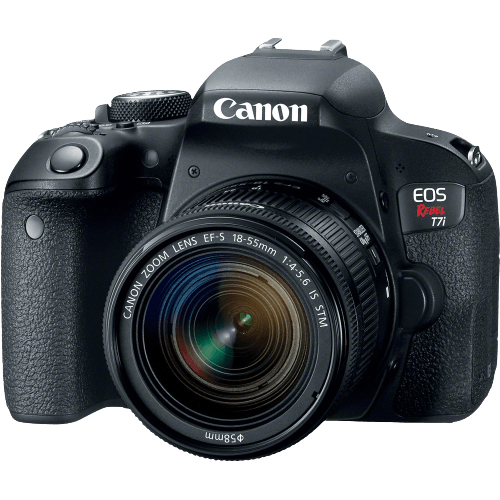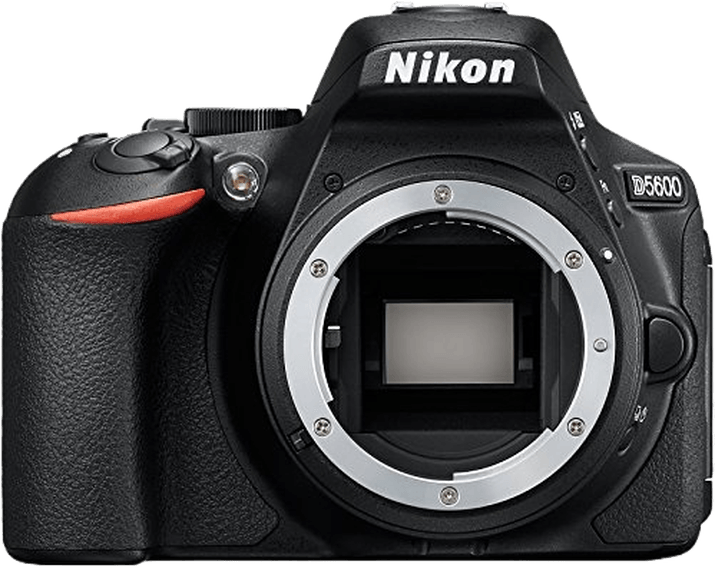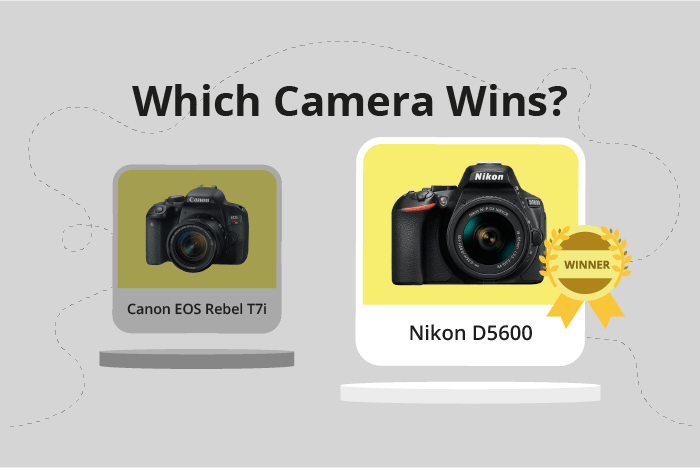Canon EOS Rebel T7i / 800D vs Nikon D5600 Comparison
Canon EOS Rebel T7i / 800D

Nikon D5600

The Nikon D5600 takes the lead with a score of 66/100, while the Canon EOS Rebel T7i / 800D trails closely behind at 64/100. Both cameras are DSLRs released in 2016 and 2017, respectively. They share similarities such as launch prices ($700 for Nikon D5600 and $779 for Canon T7i) and camera sizes (Nikon D5600: 124 x 97 x 70mm; Canon T7i: 131 x 100 x 76mm).
The Nikon D5600 stands out due to its lighter weight of 465g (1.03lbs) compared to the Canon T7i’s 532g (1.17lbs). On the other hand, the Canon T7i has the advantage of being a newer model, offering potential improvements in technology and features.
Taking these factors into consideration, the Nikon D5600 is the winner by a small margin, mainly due to its lighter weight. The Canon T7i, however, remains a strong contender with the possibility of updated features.
Canon EOS Rebel T7i / 800D vs Nikon D5600 Overview and Optics
The Nikon D5600 narrowly wins in optics with a score of 65/100, compared to the Canon EOS Rebel T7i / 800D’s score of 64/100. Both cameras share several specifications, including 24 and 24.2 megapixels, CMOS sensor type, APS-C sensor size, and lack of image stabilization. Their lens mounts also cater to their respective brands, with the Canon using EF/EF-S and the Nikon using F DX.
The Nikon D5600 surpasses the Canon T7i in terms of its sensor performance, boasting a DXOMARK score of 84 compared to the latter’s 79. This difference signifies that the D5600’s image quality is slightly superior. Additionally, the Nikon camera has a marginally higher megapixel count at 24.2, compared to the Canon’s 24.
On the other hand, the Canon EOS Rebel T7i / 800D outperforms the Nikon D5600 in shooting speed, delivering six frames per second as opposed to the Nikon’s five. This advantage allows the Canon camera to capture fast-moving subjects more effectively. Furthermore, the Canon T7i features a more advanced processor, the Digic 7, compared to the Nikon’s Expeed 4, which contributes to faster processing and potentially better image quality.
In terms of optics, the Nikon D5600 emerges as the winner due to its superior sensor performance and slightly higher megapixel count. However, the Canon EOS Rebel T7i / 800D holds its own with a faster shooting speed and a more advanced processor. Ultimately, the choice between these two cameras depends on the user’s priorities and preferences in terms of image quality and speed.
Canon EOS Rebel T7i / 800D vs Nikon D5600 Video Performance
The Canon EOS Rebel T7i / 800D and the Nikon D5600 both have a video score of 70/100, indicating that they are evenly matched in terms of video capabilities. Both cameras share the same maximum video resolution of Full HD, with video dimensions of 1920 x 1080. Additionally, they both have a maximum video frame rate of 60fps and built-in time-lapse functionality.
The Canon EOS Rebel T7i / 800D excels in its user-friendly interface and responsive touchscreen, making it easier for users to navigate through settings and adjust video options quickly. This advantage enhances the overall video shooting experience for users, especially for those new to DSLR cameras.
On the other hand, the Nikon D5600 has a slightly better dynamic range and low-light performance, which can result in better video quality under certain conditions. This advantage allows users to capture more details in challenging lighting situations, providing more flexibility for video shooting.
Taking these factors into consideration, the Canon EOS Rebel T7i / 800D is the better choice for users who prioritize ease of use and a responsive interface, while the Nikon D5600 is more suitable for those who require better low-light performance and dynamic range in their video shooting. Ultimately, both cameras offer strong video capabilities, and the deciding factor will depend on the specific needs and preferences of the user.
Canon EOS Rebel T7i / 800D vs Nikon D5600 Features and Benefits
The Nikon D5600 emerges as the winner in this comparison, with a feature score of 72/100, while the Canon EOS Rebel T7i / 800D trails slightly behind with a score of 70/100. Both cameras share several key specifications, making them quite similar in terms of features.
Both the Canon T7i and the Nikon D5600 have a touchscreen and a flip screen, making it convenient for users to navigate through settings and capture images from various angles. Additionally, both cameras are equipped with WIFI and Bluetooth connectivity, allowing for easy transfer of images and remote control using compatible devices.
The Nikon D5600 has a slight advantage in terms of screen size, with a 3.2-inch display compared to the Canon T7i’s 3-inch screen. This provides a larger viewing area for composing and reviewing images. However, the difference in screen resolution is negligible, with the Canon T7i at 1,040,000 dots and the Nikon D5600 at 1,037,000 dots.
The Canon T7i has a notable advantage in having GPS functionality, which the Nikon D5600 lacks. This feature allows users to geotag their images, providing valuable information about the location where the photos were taken.
Despite the Nikon D5600’s slightly higher feature score, both cameras offer a range of useful features to suit various photography needs. The Canon T7i’s GPS functionality may appeal to travel photographers, while the larger screen on the Nikon D5600 could be beneficial for those who prioritize display size. Ultimately, the choice between these two cameras depends on the specific preferences and requirements of the user.
Canon EOS Rebel T7i / 800D vs Nikon D5600 Storage and Battery
The Nikon D5600 outperforms the Canon EOS Rebel T7i / 800D in the storage and battery category, scoring 43 out of 100 compared to the Canon’s 29. Both cameras share similarities in storage, featuring a single memory card slot compatible with SD, SDHC, and SDXC (UHS-I) cards. Neither camera offers USB charging.
The Nikon D5600’s advantage lies in its superior battery life, providing 970 shots per charge with its EN-EL14a battery. This significantly surpasses the Canon T7i / 800D, which offers 600 shots using its LP-E17 battery.
Though the Canon T7i / 800D falls short in battery life, it still delivers a satisfactory performance for casual photographers. However, the Nikon D5600 is the clear winner in this comparison, offering longer shooting sessions and greater flexibility for extended photography projects.
Alternatives to the Canon EOS Rebel T7i / 800D and Nikon D5600
Are you still undecided about which camera is right for you? Have a look at these popular comparisons that feature the Canon EOS Rebel T7i / 800D or the Nikon D5600:

